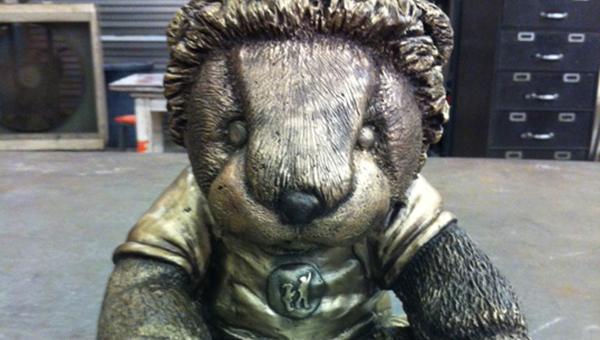On Oct. 5, Wedderspoon and three of his students, Kelly Shannon, Meredith Randall and Eric Nubbe, raised $46,000 for the Children’s Hospital of Alabama at a Nucor Steel charity auction.
“Nucor contacted me to see if me or any of my students would be interested in working with them to design a big auction item with the only parameters being that it incorporated Nucor and the Children’s Hospital,” Wedderspoon said.
Shannon, a graduate student studying studio arts, created an illuminated globe made of Nucor steel and glass which sold for $9,000.
“For my design I tried to integrate the symbols of the event, playing logos from Nucor and Children’s Hospital off a large geodesic golfball shape in steel,” Shannon said. “Working on the project turned out to be really diverting in that my own sculpture tends to be very organic and this one was so rigid and geometric.”
Randall’s topographical map of a golf course and Nubbe’s model of Children’s Hospital went for $6,000 and $11,000, respectively. Wedderspoon said he based his bronze lion, which sold for $20,000, off a stuffed animal the hospital gives to children.
“Simon the lion is a little stuffed animal and mascot of Children’s Hospital,” Wedderspoon said. “Every child admitted is given this little lion, so they always have a buddy.”
Nucor originally was only looking for one big item for its auction. Each of the sculptors went to a meeting last spring to pitch their ideas.
“They loved all the ideas so much, they said, ‘Well can we do them all?’” Wedderspoon said. “Rather than just having one big money item, they’ll have four.”
Shannon said one of the biggest challenges for her was maintaining precision when creating her globe. Despite the challenge, Shannon said she loved being able to help out the hospital.
“The geodesic design was challenging in that it needed to be so precise, and then trying to maintain that same level of precision cutting out the Nucor logos was more difficult than expected,” she said. “Any level of effort that goes to such a good cause feels worthwhile because you know it hasn’t been wasted.”
Wedderspoon had nothing but praise for the astronomy and physics machine shop that helped the sculptors complete their work, he said. The machine shop, ran by Joe Howell, David Key and Michael Perrigin, helped the sculptors with the finer details of the sculptures and without them, Wedderspoon said the project would have taken longer to complete.
“They helped us do all the milling and all the cutting out of letters for logos,” he said.
Shannon said sculpting allows her to use a variety of different interests such as math, art and engineering in a physical way. She said she’s wanted to be a sculptor ever since ninth grade.
Wedderspoon and the other sculptors spent many hours working on the project. Wedderspoon’s own bronze “Simon the Lion” took around 150 hours to complete.
“I had to model it in clay first. I’d never modeled a stuffed animal in clay before, so that’s probably one of the most difficult things I’ve ever done,” he said. “It took a couple of weeks.”
Tricia McElroy-Fair, associate dean of humanities and fine arts, said the sculptors represented the University well by producing inspirational and creative works for a good cause. McElroy-Fair said Wedderspoon gave the three students a wonderful opportunity to be recognized in the artistic world.
Wedderspoon said one of the hardest challenges with the project and sculpting in general is taking a creation from an idea to a final result.
“All three had such great ideas, but it’s the realization of those ideas,” Wedderspoon said. “You’re doing everything from idea to final delivery of product, and you’re doing all the dirty stuff – all the welding, all the grinding, all the long hours.”









